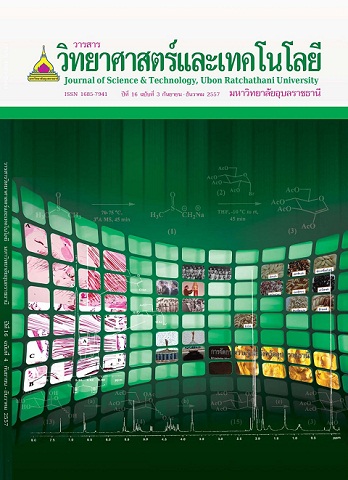การศึกษาปฏิกิริยาการกำจัดของสารกลูโคซิลโบรไมด์ที่เหนี่ยวนำโดยดิมซิลแอนไอออน
Main Article Content
บทคัดย่อ
งานวิจัยนี้เป็นการศึกษาปฏิกิริยาระหว่างดิมซิลแอนไอออนและสารไกลโคซิลโบรไมด์ เพื่อให้เข้าใจกลไกการเกิดสารผลิตภัณฑ์ การทดลองพบว่า จะได้ผลิตภัณฑ์เป็นสาร 2-อะซีทอกซีกลูคาลซึ่งเกิดผ่านปฏิกิริยาการกำจัดกรดไฮโดรโบรมิกเพียงชนิดเดียวและไม่พบสารผลิตภัณฑ์ข้างเคียงซึ่งเกิดจากปฏิกิริยาการแทนที่ นอกจากนี้ในงานวิจัยได้ศึกษาปัจจัยอื่นที่อาจมีผลต่อการเกิดปฏิกิริยา ได้แก่ หมู่ปกป้องสารไกลโคซิลโบรไมด์ การเข้ามีส่วนร่วมของหมู่ข้างเคียงบนโมเลกุลสารไกลโคซิลโบรไมด์ และชนิดคู่ไอออนโลหะประจุบวกของดิมซิลแอนไอออน ผลการศึกษาพบว่า ปัจจัยเหล่านี้ไม่มีผลต่อการเปลี่ยนแปลงการเกิดปฏิกิริยา จากผลการศึกษา ทำให้สามารถสรุปได้ว่าในงานวิจัยนี้ดิมซิลแอนไอออนแสดงสมบัติความเป็นเบสมากกว่านิวคลีโอไฟล์และปัจจัยนี้น่าจะเป็นปัจจัยหลักในการทำให้เกิดปฏิกิริยาการกำจัดไฮโดรเจนโบรไมด์ออกจากสารตั้งต้นกลูโคซิลโบรไมด์เพียงชนิดเดียวโดยไม่เกิดผลิตภัณฑ์ที่เกิดจากการแทนที่โบรไมด์ด้วยดิมซิลแอนไอออนเลย โดยสารเคมีทุกชนิดที่สังเคราะห์ได้ยืนยันโครงสร้างทางเคมีด้วยเทคนิคทางเอ็นเอ็มอาร์สเปกโทรสโกปี
Exploratory Study of Dimsyl Anion-Induced Elimination Reaction of Glycosyl Bromides
This research studied the reaction between dimsyl anion and glycosyl bromides to understand the mechanism of the products formed. It was found that the corresponding products were 2-acetoxy glucals which resulted from the elimination of hydrobromic acid with no trace of the substitution product. The research also explored possibly related factors including the protecting group of the glycosyl bromide, neighboring group participation on the sugar moiety of the glycosyl bromide, and metal counter-ion of dimsyl anion. Results showed that none of these factors changed the observed chemical outcomes. However, it was concluded that dimsyl anion showed more base than nucleophilic for these reactions. This could possibly be the main factor resulting in the exclusive elimination of hydrogen bromide from starting glycosyl bromides without the substitution of bromide by dimsyl anion. All synthesized chemicals were elucidated by nuclear magnetic resonance (NMR) spectroscopic techniques.
Article Details
บทความที่ได้รับการตีพิมพ์เป็นลิขสิทธิ์ของ วารสารวิทยาศาสตร์และเทคโนโลยี มหาวิทยาลัยอุบลราชธานี
ข้อความที่ปรากฏในบทความแต่ละเรื่องในวารสารวิชาการเล่มนี้เป็นความคิดเห็นส่วนตัวของผู้เขียนแต่ละท่านไม่เกี่ยวข้องกับมหาวิทยาลัยอุบลราชธานี และคณาจารย์ท่านอื่นๆในมหาวิทยาลัยฯ แต่อย่างใด ความรับผิดชอบองค์ประกอบทั้งหมดของบทความแต่ละเรื่องเป็นของผู้เขียนแต่ละท่าน หากมีความผิดพลาดใดๆ ผู้เขียนแต่ละท่านจะรับผิดชอบบทความของตนเองแต่ผู้เดียว


